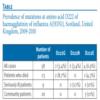
Kilander et al. (2010) [1] have previously reported that in some cases of patients with severe or fatal pandemic influenza A(H1N1), an amino acid substitution from aspartic acid to glycine occurs at position 222 (D222G) of the HA1 subunit of haemagglutinin (HA). In their study 11 (18%) of 61 patients with severe disease had the mutation, in contrast to 0 of 205 patients with mild disease.
Since the original report [1] several countries have detected this mutation [2]. This data has been summarised in a recent World Health Organization (WHO) review, which reported that the overall prevalence of D222G was <1.8% in contrast to a rate of 7.1% in fatal cases [2]. The WHO paper also reports on the occurrence of other mutations at this amino acid, D222E and D222N, although their significance is unclear. A group in Hong Kong have also analysed this amino acid in severe and non-severe cases of pandemic influenza A(H1N1) [3]. In this study nine (4.1%) of 219 severe or fatal cases of pandemic influenza A(H1N1) had the D222G mutation, in contrast to 0 of 239 non-severe cases.
We sequenced the HA1 subunit of the HA gene from a number of West of Scotland cases, both community cases and severely ill. Furthermore we subdivided the severely ill into those who had died and those who recovered after hospitalisation. We found an increased incidence of D222G in those patients who died (2/23 - 8.7%) compared to both community and hospitalised patients (0/35 - 0%). We also detected an increased incidence (2/32 - 6.2% cf 0/26 - 0%) of D222N (aspartic acid to asparigine) in severely ill patients and those who had died. The significance of this mutation is unclear. There was a low level of D222E (aspartic acid to glutamic acid) present in both severely ill and community cases with no significant difference between the two. The results are summarised in the Table.
Table. Prevalence of mutations at amino acid D222 of haemagglutinin of A(H1N1), Scotland, United Kingdom, 2009-2010
Interestingly, in one of the patients who died and had the D222G mutation, the original sequence had a mixed base in the D222 codon giving D222D/G. On resequencing two more samples from this patient, we obtained a pure D222G on one occasion and a pure wildtype D222 on the other, showing that this patient had a mixed population of virus. This confirms the finding in Kilander’s paper [1] of the co-existence of mutant and wildtype virus.